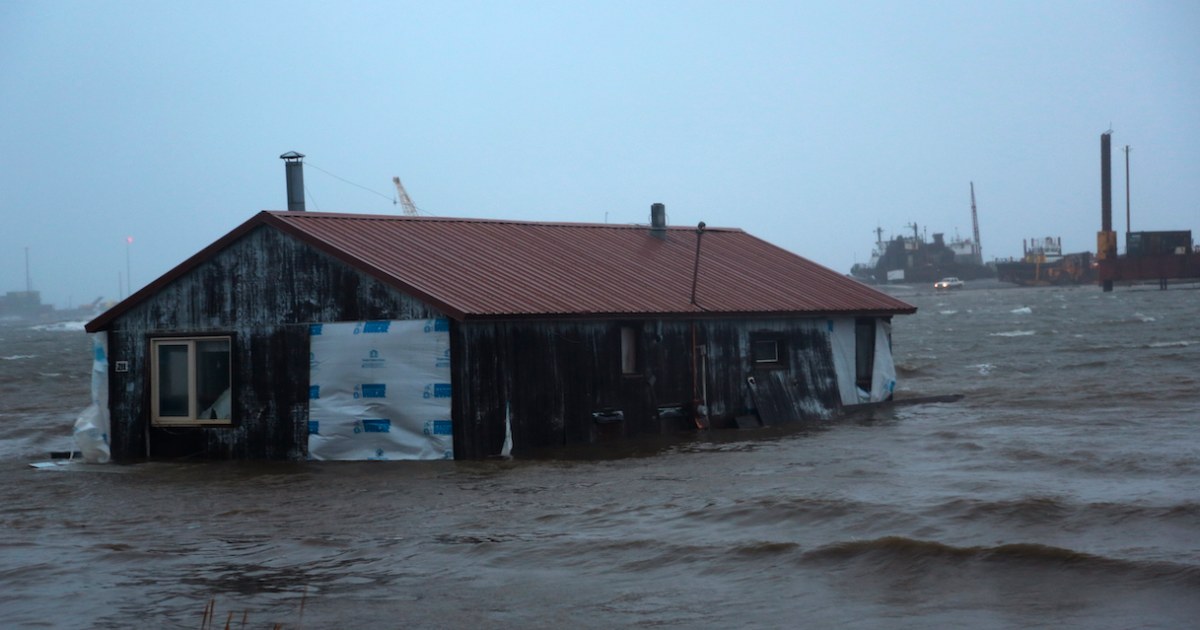By Mark Thiessen and Jocelyn Gecker
Associated Press
ANCHORAGE
— A powerful storm moving north across the Bering Strait on Saturday caused widespread flooding in several coastal communities in western Alaska, causing power outages and many residents to flee to higher ground.
Due to their force, the currents ripped some houses off their foundations, and a house in Nome that floated as it was being swept downstream got stuck on a bridge.
[Tropical Storm Fiona threatens to become a hurricane]
The storm is a remnant of Typhoon Merbok, a storm that also influences weather patterns as far away as California, where high winds and a rare late-summer downpour are forecast.
In Alaska, there are no reports of deaths or injuries from the storm, said Jeremy Zidek, a spokesman for the Alaska Department of Homeland Security and Emergency Management.
Authorities had warned communities that some places could experience the worst flooding in 50 years and that it would take up to 14 hours for the waters to subside.
A house floated on the Snake River near Nome, Alaska on Saturday, September 17.
The rains and flooding forced many residents of the coastal region to flee to higher ground. Peggy Fagerstrom / AP
Governor Mike Dunleavy issued a disaster declaration for affected communities on Saturday.
Residents sought refuge
The town of Golovin, which was among the hardest hit, with most of the roughly 170 residents taking refuge in a school or three buildings on top of a hill.
The winds in the area exceeded 95 kilometers per hour (60 mph), the water level was 3.35 meters (11 feet) above the normal tide line and it was expected that it could rise another 61 centimeters (two feet). on Saturday before reaching its highest level.
[NOAA predicts between 6 and 10 hurricanes in the Atlantic for the 2022 season]
“Most of the lower-lying areas of the community are submerged and structures and buildings are flooded,” said Ed Plumb, a hydrologist with the National Weather Service in Fairbanks.
Clarabelle Lewis, a facilities manager for the tribal government, the Chinik Eskimo Community, was among those who took refuge on the hill across from Golovin.
She and others were weathering the storm at the tribal office after protecting items in their homes from the winds and helping their neighbors do the same.
Tropical Storm Fiona will strengthen before passing through the Dominican Republic
Sept.
18, 202201:14
“The winds howled;
it was loud,” he said.
Lewis has never experienced a storm like this in the 20 years he has lived in Golovin.
“We have had several floods in the past, but it was never this bad,” he said.
"We've never seen cases that moved off their foundations."
[Tropical Storm Lester dissipates as it makes landfall on the Mexican Pacific coast]
There were also reports of flooding in Hooper Bay, St. Michael's, Unalakleet and Shaktoolik, where waves broke over the coastal wall in front of the community, Ed Plumb said.
The specialist explained that the storm will cross the Bering Strait on Saturday and then head to the Chukchi Sea.
Front Street in Nome, Alaska, flooded by the storm that has hit this region in the Bering Sea.
Peggy Fagerstrom/AP
"And then it's going to plateau and weaken just west of Point Hope," he said of the community on Alaska's northwest coast.
He explained that high tides are expected in the northern region of the Bering Sea until Saturday night, before beginning to subside on Sunday.
Rising water levels further north, in the Chukchi Sea and Kotzebue Sound, could persist into Sunday.
California is also affected
In Northern California, wind gusts of up to 40 mph (64 kph) are forecast Saturday night through Sunday morning along coastal areas from Sonoma County to Santa Cruz and at higher elevations. Sierra Nevada highlands, the National Weather Service said.
Winds of that force can blow down drought-stressed branches and trees and cause power outages, said Weather Service Meteorologist Ryan Walbrun.
Puerto Ricans prepare for the arrival of Tropical Storm Fiona
Sept.
17, 202202:12
The storms are expected to begin Sunday morning and drop up to 3 inches (7.6 centimeters) of rain in coastal areas of Sonoma County and slightly less as the rains move south into the area of San Francisco and into the Santa Cruz mountains, Walbrun said.
"That's pretty significant rain for this early in the season," he said, adding that storms are forecast to last on and off through at least Monday.

